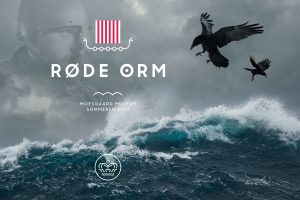Roaring warriors, pomp and circumstance, a tough drama set against the historical background of the Viking era. That goes down like cake (or beer) with the Danes who see themselves as direct heirs of the Vikings, the organisers must have thought. And that is why the play Røde Orm is presented as one of the highlights of Aarhus' year as European Capital of Culture. In short, an event with a high 'I-was-there' content.
Although made especially for Aarhus, Røde Orm is part of a Copenhagen, if not Danish, tradition. Every three years since 1996 (when Copenhagen was European capital of culture), the Danish Kongelige Teater has performed at Ulvedalene. That is the open-air theatre in Dyrehaven, a centuries-old landscape park north of Copenhagen. So those who can't make it to Aarhus this year can still experience Røde Orm in Copenhagen next year.
The organisers have spared no expense for a theatre show that (by their own admission) may be the biggest of 2017 in Europe. Three horses and more than a hundred actors, volunteers and technicians work in front of and behind the scenes. Three thousand visitors per performance can sit in the stands. A partially covered stage in the shape of a Viking ship, including a fire-breathing figurehead, accommodates an intimate bed scene as easily as a drinking party or a royal audience. Ingenious Viking ships sway on waves of blue umbrellas, spun around by extras. But the landscape behind the stage also gets involved: this is where the Vikings fight their battles.
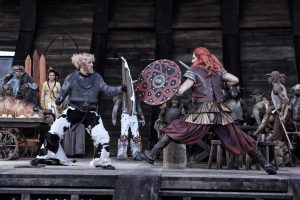
Balance lost
But it is precisely in the fight scenes that a shortcoming of the show becomes apparent: there are too few volunteers who wanted to participate as extras. As recently as February this year, recruitment was brisk, but it is far from a hundred people playing for soldier, or looted villager, or blue wave. The contrast between mass scenes and more intimate scenes does not come across.
The same lack of contrast applies to the acting itself. Almost all scenes thunder past at roaring levels, and the actors indulge themselves with fervour in overacting. Red Orm, the main character played by Andreas Jebro, is your very own Viking Action Man. Child king Ethelred of England behaves like a spoilt little child, and to add some strength to his childishness, he lunges at the breasts of his nannies. The villains are intensely mean, the Vikings are at least as violent - hooligans avant-la-lettre so to speak - but good hooligans. That's another thing: the unsuspectingness with which Danes look away from the less pleasant sides of being a Viking (Dorestad!) is a bit toe-curling at times.
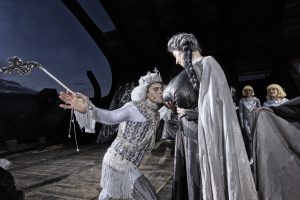
Red thread of Red Orm
The story is based on two novels by Swede Frans Gunnar Bengtsson, which had immediate great success upon publication. (Incidentally, three years ago reissued in the Netherlands as The Longships). The play concerns the episode in which Red Orm, back from a successful rampage, meets his great love Princess Ylva at the court of her father, King Harald Blauwtand (yes, the one from Bluetooth). Her he must have! And he gets her, too. He just needs to knock the child king of England off the throne and defeat his rival Earl Byrhtnoth. Because Ylva's nefarious brother Svend Tweebaard has sent her to England to marry the Earl. And he must become a Christian for a while, because without God's help no one sails.
[bol_product_links block_id=”bol_59313319b567b_selected-products” products=”9200000015493935,9200000024800802″ name="langscepen" sub_id="inger" link_color="003399″ subtitle_color="000000″ pricetype_color="000000″ price_color="CC3300″ deliverytime_color="009900″ background_color="FFFFFF" border_colour="D2D2D2″ width="500″ cols="2″ show_bol_logo="0″ show_price="1″ show_rating="1″ show_deliverytime="1″ link_target="1″ image_size="1″ admin_preview="1″]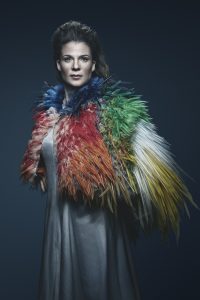
Princess stands her ground
Ylva, played by Christine Gjerulff, stands her ground. And more than that. On horseback, in a snow-white dress and a colourful feather collar, she comes on and roars one tough rejoinder after another, when she's not slaughtering bad guys in a sword fight. But hers are also the sparse one-liners that give the performance a little more relief. In the love scene with Red Orm, for instance, she asks him if he doesn't want something other than to 'dismember people honourably'. And at the end of the play, when Orm and she take their wedding vows, she does not say 'yes' but 'I'll do my best' - with a raised eyebrow in the direction of the audience. Clearly, Ylva has no talent for submission.
There are more nuances, but you have to see them. For instance, on the roof of the stage, two raven figures hop around: the messengers of the gods Huginn and Muninn. They record everything that happens and pass it on to supreme god Thor. But after the interval, the ravens have given way to a Celtic cross, symbolising Christianity to which King Harald Blauwtand and later Orm have converted.
Valhalla's door policy
As a non-Viking, what should you do with this performance?
If you don't understand Danish, two and a half hours is quite a long time to be entertained by lavish costumes, sword fights and other blast effects. Or watching the audience - an anthropological experience in itself.
Those who do understand Danish, on the other hand, can follow the play unusually well. Because unlike in acclaimed Danish TV series such as Borgen or The Bridge, here the play is clearly articulated and not mumbled.
Furthermore, I find the performance rather flat. Not just because it's all laugh-out-loud humour, but also because the humour is rather often below the belt. And in some places, the show definitely crosses the edge from comical to laughable. Lyrics like, "And who are you, that you think you can sit in my place!!!" or "Røde Orm, you will die!!! WRAAAAAAAHHH! " are so old-fashioned they make you laugh out loud.
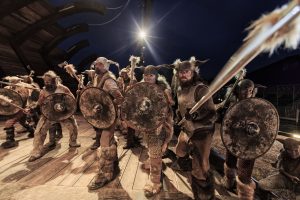
What also doesn't help is that the very costumes of the tough Vikings are so over-the-top that it has the opposite effect. Waving feathers, nuffy fur and shaggy plaster eyebrows are more reminiscent of the musical Cats than of a swarm of robber knights-at-sea. Well, cats are no slouch when it comes to violence either, but still. To compensate, they do roar often, loudly and masculinely, but whether that will get you into Valhalla with your plastered eyebrows... I doubt it.
Code not cracked
Apart from that, I increasingly got the feeling that the rest of the Danish audience had a prior knowledge or context that I, as a foreigner, lacked. I can't get that code cracked.
Is it the background of community play, large-scale plays featuring amateurs from one village or town, which took off in Scandinavia in the 1970s? Director Frede Gulbrandsen grew up in that tradition. He also has a long series of plays to his name, based on popular books. Astrid Lindgrens Lionheart brothers and Alexandre Dumas' Three musketeers include books he has successfully adapted into plays. All in the tough-guy genre, by the way.
Is it the background of the comic book series Valhalla? Several people said after the show that it reminded them of a comic book. And then the name Valhalla, a Danish cartoon series from the 1980s that initially appeared in the daily newspaper Politiken. In it, Norse mythology is loosely retold - think Asterix and Obelix, but Scandinavian style.
Or is it the unsuspecting glorification of alcohol abuse and related hooliganism, which can be seen (and condoned) up close in the Danish inner cities every weekend in a non-Viking context?
Probably a mixture of all three. But: you must have seen it. That is. Herewith then.
